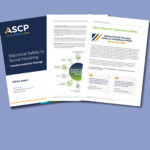Recognising that electrical safety for too long has been seen as less important than gas safety within social housing, the Association of Safety and Compliance Professionals (ASCP) has launched its White Paper: Electrical Safety in Social Housing, Transformational Change.
Written following extensive consultation with ASCP and Association of Electrical Safety Managers (AESM) members, the White Paper seeks to highlight the complexity of the work safety and compliance professionals do within electrical safety, to help them be more effective in this work and to support them in challenging the status quo where necessary. It sets out the findings of the AESM Think Tank on electrical safety as well as the common themes identified by ASCP members in discussions, round table events and surveys.
Electrical safety has generally been seen as less important than gas safety despite clear evidence that each year unsafe electrical work causes more injuries, fatalities and devastation to families and communities. The fewer incidents related to gas is largely due to the annual requirement of the landlord gas safety check. Every year, almost half of all accidental house fires in the UK are caused by electrical appliances. Electrical goods were, for example, the source of ignition in the fires at Grenfell, Lakanal House and Shepherd’s Court. The Grenfell tragedy in particular, where 72 people lost their lives in June 2017, remains an emotive and powerful driver for change.
There is clearly a will for change and progress has undoubtedly been made in this area. However more than three years after the publication of Dame Judith Hackitt’s Building a Safer Future report, accusations still remain that the shift is not happening quickly enough. The ASCP’s White Paper calls on the sector to be reflective and bold in addressing this perceived lack of activity and in challenging complacency. It considers what the obstacles might be to strengthening safety cultures and sets out recommendations to support positive change. Specific considerations are set out for each individual department within organisations, with the aim of ensuring that safety becomes everyone’s collective responsibility and one which is understood, prioritised and given sufficient focus at every level of an organisation.
The White Paper considers the potential introduction of a regulatory 5 Year Inspect and Test Programme within social housing. Such a programme is seen by many as necessary in order to address electrical safety issues within the sector. There are, however, a number of implications and caveats which the White Paper sets out in order that they can receive the necessary careful consideration before any new regulations are implemented. One such consideration, with the potential to pose a serious risk to safety and compliance, is access. One aim of the White Paper is to address some of the issues surrounding access and to look at some possible solutions. Recommendations to improve resident engagement are also outlined in order to improve access, minimise unsafe behaviours and reduce incidents.
The White Paper concludes by outlining some potential next steps for the sector and the ways in which the ASCP will be providing support and driving change. There is no denying the task ahead is vast and challenging but, as Claire Heyes, CEO of the ASCP Group summarised: “We have an opportunity now to rethink how we manage electrical safety across the whole sector. By harnessing our collective wisdom and expertise, the sector can achieve truly transformational change and ensure that tragedies such as Grenfell are never repeated. Together we can build a safer future for everyone.”
Download the White Paper for free here: Electrical Safety in Social Housing, Transformational Change.









